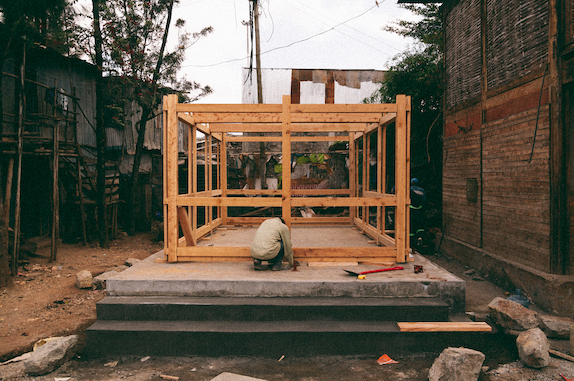Giacomo Moor for LiveinSlums
Photos and videos by Francesco Giusti, Filippo Romano, Alessandro Treves
Curated by Davide Fabio Colaci in collaboration with Federica Sala from a project of LiveinSlums
April 2024
Giacomo Moor for LiveinSlums
Photos and videos by Francesco Giusti, Filippo Romano, Alessandro Treves
Curated by Davide Fabio Colaci in collaboration with Federica Sala from a project of LiveinSlums
April 2024
SPECIAL OPENING HOURS FOR ART WEEK & DESIGN WEEK
From April 14 to April 21, 2024
From 11 a.m. to 7 p.m.
OPENING HOURS
From April 22 to April 28, 2024
From 3 p.m. to 7 p.m.
Free access with Assab One 2024 membership card (€10)
OPENING
Saturday, April 13 from 3 p.m. to 9 p.m.
For more information write to info@assab-one.org
Assab One presents Design for Communities – Giacomo Moor per LiveinSlums, an NGO that works in urban territories with severe critical issues, and designer Giacomo Moor. LiveinSlums has been carrying out valuable urban regeneration projects for years, providing children and youth in Mathare, one of Nairobi‘s largest slums, with the means necessary for their reintegration into school and work. At the core of its projects, LiveinSlums puts the involvement of the very inhabitants of the areas in which it intervenes, who become key figures. This practice guarantees them the quality for “lasting human growth“, but above all the autonomy necessary to carry out the projects.
In 2023 Giacomo Moor went to Mathare to make furniture for the dormitory of Why Not Academy, a school designed and built by architect Gaetano Berni, which accommodates about 300 children. The furnishings – tables, benches, and bunk beds – were designed from a construction system, based on sequential interlocks, that can be applied to different pieces of furniture.
In 2024, LiveinSlums continues its collaboration with Giacomo Moor who this year went to the slum to build the kitchen premises for the canteen. Located in the courtyard of the complex and elevated on a concrete podium that protects it from weather and flooding, this minimal unit was built together with the local community using a modular construction system. A structural, yet lightweight, solid wood primary frame sets the design of the elevations with a constant rhythm and, thanks to its special geometry, allows a series of secondary panelling to slide within it.
Ease of adapting sizes in the three dimensions, constructive autonomy among parts, and easy replacement of each component are the design criteria that make this microarchitecture extremely flexible and adaptable to very different socio-environmental contexts.
Alessandro Treves, who has followed the construction of the architecture, will feature in the exhibition a photographic work resulting from his long stay on site.
To tell the public about the project, the spaces of Assab One, during Milan Design Week, will host an exhibition in which the microarchitecture, in full scale, reconfigured on the space and the photographic research of Alessandro Treves will be displayed.
Special thanks go to Koalisation, a partner in the realization of the kitchen in Mathare who donated four highly innovative cooking systems.
